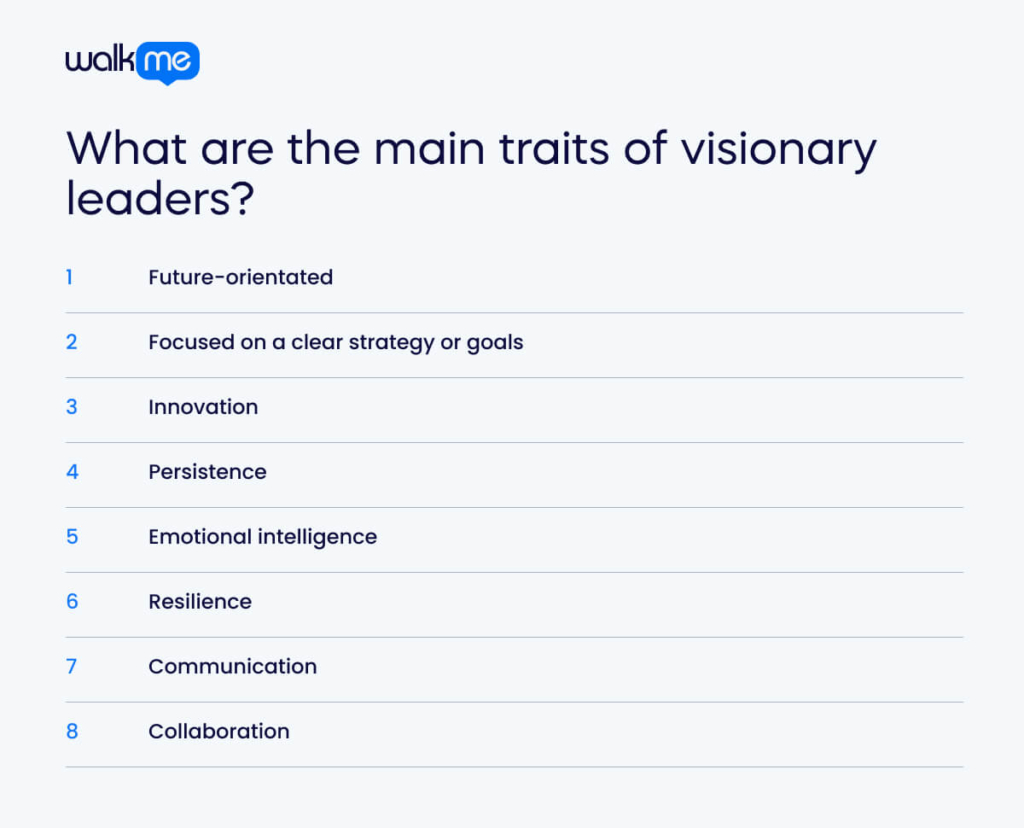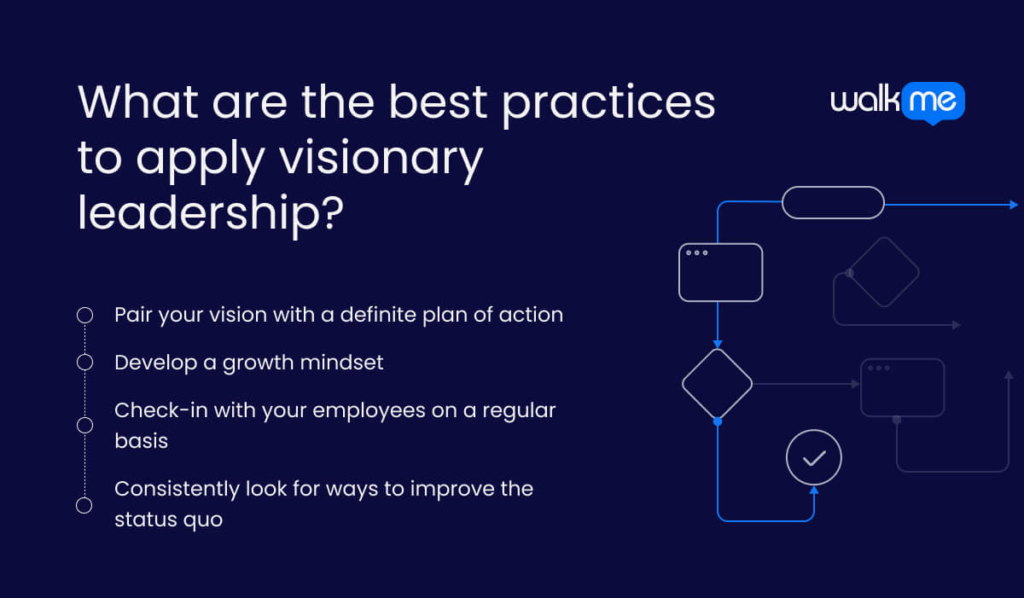Visionary leadership is all about looking to the future and guiding teams toward new possibilities. These leaders inspire, think ahead, and drive innovation by painting a clear picture of what success could look like.
Because they focus on transformation, visionary leaders often play a crucial role in leading change management initiatives, helping teams adapt to evolving goals and shifting environments.
In this article, we’ll explore what defines visionary leadership, highlight key traits, and share real-world examples of visionary leaders. We’ll also dive into best practices for this leadership style, along with its advantages and potential challenges.
What is visionary leadership?
Visionary leadership is a type of leadership that focuses on the future. It is innovative and imaginative. Visionary leaders can see the big picture and think of new ways to achieve their goals.
They have a leadership vision for the future and aim for a positive impact. They often seek to change the current way things are done. At their core, visionary leaders want to change the world, and they have the means to do it.
What are the main traits of visionary leaders?

The main characteristics of visionary leaders are the key qualities that allow them to inspire, innovate, and guide their teams toward ambitious goals.
These leaders possess a unique ability to look ahead and shape the future, combining creativity, strategic thinking, and emotional intelligence.
Visionary leaders focus on long-term success, driving innovation while fostering collaboration and resilience within their teams. Through clear communication and persistence, they turn their bold ideas into reality.
Future-orientated
Visionary leaders focus on the future. Their vision for the organization is set in an uncertain time ahead. This could mean creating a market in a new industry.
No matter the goal, visionary leaders stay focused on the future. They make ongoing improvements to reach it.
Focused on a clear strategy or goals
Having a clear vision of the future makes it easier to create a strategy to achieve it. Visionary leaders are good at developing detailed plans to reach their goals.
Visionary leaders know that individuals, teams, and nations must align with the vision. Everyone must have a clear goal and understand their role in making the vision a reality.
Innovation
This type of leader thinks creatively and looks beyond the usual ways of doing things. They have a clear vision for the future. Visionary leadership means you are willing to take smart risks to achieve your goals.
They allow themselves to dream big. You can also encourage your teams to do the same. It helps them succeed and shapes the organizational culture.
Persistence
Visionary leaders understand that carrying out their vision will be challenging. This challenge fuels their determination to succeed, and overcoming obstacles makes the achievement even more rewarding.
This type of leader knows how to handle challenges and push through them. They encourage their team not to give up, no matter how tough things get.
Emotional intelligence
To be a great visionary leader, you must be aware of your emotions and those of others.
When you recognize other people’s feelings, you can influence them. This helps make others want to follow your vision.
Emotional intelligence means that leaders need to be self-aware. They should understand their own emotions and build a positive mindset.
Resilience
All leadership styles need a high level of resilience. This means the ability to adapt to difficult situations.
Visionary leaders often face obstacles as they work toward their vision. Resilience helps them stay focused and handle challenges. With their big-picture thinking and strong determination, they navigate tough situations and guide their teams to success.
Communication
To carry out a visionary leader’s plan, everyone in the company must be aligned with the mission. When people understand the mission, they feel more purpose in their work.
Strong communication skills are necessary for this. If leaders fail to communicate clearly, the team may lose interest and not work as hard. They won’t know what they are working toward. Ongoing conversations between leaders and their teams are essential for success.
Collaboration
Visionary leaders will talk about working together. However, collaboration goes beyond cooperation. It connects team members’ skills with goals that promote growth.
Collaboration builds strong relationships and allows others to do their best work. Encouraging and engaging others makes the vision more achievable and increases team commitment.
What are some examples of visionary leaders?
Here are some of the best examples of visionary leaders:
Elon Musk
Elon Musk is a controversial figure, but it’s hard to deny he is a visionary. He is the founder, CEO, and chief engineer of SpaceX, CEO and product architect of Tesla, and the owner of Twitter. Musk also co-founded Neuralink and The Boring Company.
Musk is determined, bold, and highly organized. His focus on constant innovation and willingness to take risks have helped him reshape several industries.
Mukesh Ambani
As Chairman and MD of Reliance Industries Limited (RIL), Mukesh Ambani turned the company into a global leader. RIL now leads petrochemicals, refining, telecom, retail, and digital services.
Ambani’s success comes from his ability to foresee trends and take bold risks. He predicted the rise of mobile communications in India, and his focus on innovation led to services like Jio Fiber.
What are the best practices to apply visionary leadership?

The most important best practices for applying visionary leadership are:
Pair your vision with a definite plan of action
Visionary leaders are good at creating vision statements and inspiring their teams. It should give the organization proper direction.
A good vision statement should be no more than two sentences long. It should describe a unique outcome that only that organization can achieve. The language should be clear and simple. It should also align with the core values of the organization.
Once the vision statement is written, identify key people to help execute it. Then, outline a strategy for tracking progress and revising the goals. Without concrete actions, the vision may stay just a vision and never become a reality.
Develop a growth mindset
Successful visionary leaders have a growth mindset, which helps them see failure as a chance to learn and grow.
By having a growth mindset, you can pursue your visionary goals. Taking smart risks also helps you move forward without fear of failure.
Practice mindfulness to manage anxiety and stay focused on your goals. When setbacks happen, take a moment to acknowledge your feelings. But don’t let those feelings take control. Instead, use resilience training techniques. This will help you bounce back stronger and more determined.
Check-in with your employees on a regular basis
Your team needs to believe in your vision as much as you do. Make sure they understand the goal’s benefits. This can help increase the chances of reaching it.
Start by meeting with your team to discuss the vision. Then, manage progress each week. Find out what tasks are easy and which ones are harder. Create solutions for the challenges they face. Use this time to give helpful feedback based on each team member’s progress.
Consistently look for ways to improve the status quo
Visionary leaders know there is always room to improve. One way to improve is to consider how the organization appears to outsiders. Based on that view, consider how you can make things better. Try using customer-centric surveys to source this information.
Another approach is to ask, “Why not?”. It can also help find new solutions to difficult problems.
Then, everyone has different strengths and work styles. It’s important to encourage team members to use their unique skills.

What are the benefits of visionary leadership?
The core benefits of visionary leadership are that it:
Brings employees together
Visionary leadership aims to create shared goals. Companies struggling to grow can benefit from the innovation and long-term thinking of a visionary leader.
This thinking improves teamwork and helps the team reach their goals with fewer conflicts.
Makes it easier to meet targets
Visionary leadership focuses on the future and long-term goals. It can give businesses an edge over those focusing only on short-term or everyday work.
A visionary leader shares their vision in a way that inspires the company. As a result, employees and stakeholders continue to follow the vision even if the leader leaves.
Allows venturing outside the comfort zone
To grow and improve, an organization cannot stay stuck in the past or get lost in the present. A visionary leader helps the team focus on an exciting future.
When a company aims for a bold goal, visionary leaders connect personal goals with the company’s vision. Feeling part of the journey makes work exciting. It also helps push the organization beyond its comfort zone.
What are the challenges of implementing visionary leadership?
The main challenges of putting visionary leadership in place are:
May not focus on the present
Visionary leaders focus on long-term goals. But if they think only about the future, they find it hard to focus on the present. They may overlook urgent problems that need attention now.
To fix this, visionaries can set aside time daily to focus on present concerns. They can also hire detail-oriented people to help them with these tasks or manage them.
Can make it difficult to make tough decisions
Visionaries are driven by creativity and positivity. They focus on what they can do, not what they can’t. Because of this, they may struggle to hear bad news or make tough decisions.
They may also misunderstand others, as not everyone shares their goals. As leaders, visionaries can hire advisors who help guide them in making hard choices.
Tunnel vision
Visionary leaders may focus too much on their main vision. They might miss important details. If they become too attached to one idea, they could ignore new ideas.
They may resist changing or dropping their vision, even if a better option appears. To avoid this, leaders should have regular brainstorming sessions. Open communication keeps them aware of new opportunities.
Use a visionary leadership approach to inspire your employees to achieve clear goals
Visionary leadership is passionate, innovative, and forward-thinking. These leaders are flexible and willing to take risks. They excel at uniting teams, building creative cultures, and focusing on long-term goals. Their main strength is creating unity and loyalty within the company.
However, visionary leaders often need to improve their ability to accept feedback, set short-term goals, and make tough decisions. While this approach has its weaknesses, visionary leadership is key to building strong, adaptable organizations. It helps teams thrive in uncertain times and lays the foundation for long-term success.
FAQs
Visionary leadership is ideal when a business needs a long-term vision to inspire employees to work together. It’s also effective if you want the team to continue pursuing goals, even if the leader leaves.
Charismatic leaders are impulsive and focus on the present, while visionary leaders are strategic and think long-term. Charismatic leaders rely on charm, while visionary leaders inspire with their vision.

